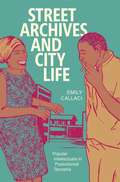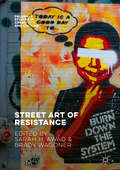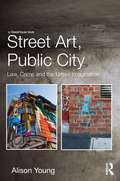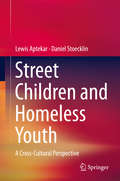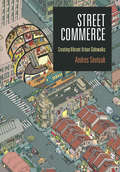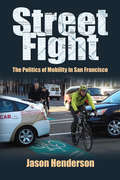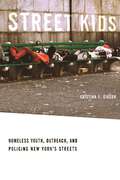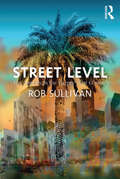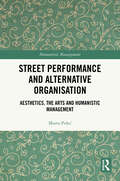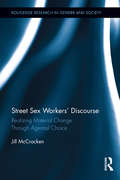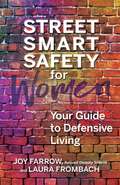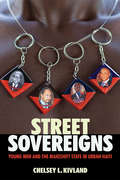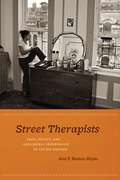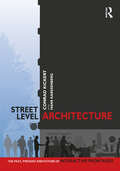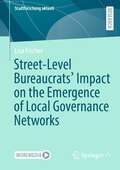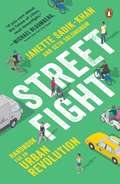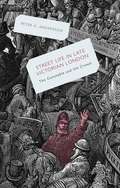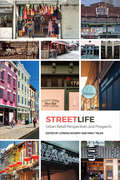- Table View
- List View
Street Archives and City Life: Popular Intellectuals in Postcolonial Tanzania
by Emily CallaciIn Street Archives and City Life Emily Callaci maps a new terrain of political and cultural production in mid- to late twentieth-century Tanzanian urban landscapes. While the postcolonial Tanzanian ruling party (TANU) adopted a policy of rural socialism known as Ujamaa between 1967 and 1985, an influx of youth migrants to the city of Dar es Salaam generated innovative forms of urbanism through the production and circulation of what Callaci calls street archives. These urban intellectuals neither supported nor contested the ruling party's anti-city philosophy; rather, they navigated the complexities of inhabiting unplanned African cities during economic crisis and social transformation through various forms of popular texts that included women's Christian advice literature, newspaper columns, self-published pulp fiction novellas, and song lyrics. Through these textual networks, Callaci shows how youth migrants and urban intellectuals in Dar es Salaam fashioned a collective ethos of postcolonial African citizenship. This spirit ushered in a revolution rooted in the city and its networks—an urban revolution that arose in spite of the nation-state's pro-rural ideology.
Street Art of Resistance (Palgrave Studies in Creativity and Culture)
by Brady Wagoner Sarah H. AwadThis book explores how street art has been used as a tool of resistance to express opposition to political systems and social issues around the world. Aesthetic devices such as murals, tags, posters, street performances and caricatures are discussed in terms of how they are employed to occupy urban spaces and present alternative visions of social reality. Based on empirical research, the authors use the framework of creative psychology to explore the aesthetic dimensions of resistance that can be found in graffiti, art, music, poetry and other creative cultural forms. Chapters include case studies from countries including Brazil, Canada, Chile, Denmark, Egypt, Ireland, Mexico and Spain to shed new light on the social, cultural and political dynamics of street art not only locally, but globally. This innovative collection will be of particular interest to scholars of social and political psychology, urban studies and the wider sociologies and is essential reading for all those interested in the role of art in social change.
Street Art, Public City: Law, Crime and the Urban Imagination
by Alison YoungWhat is street art? Who is the street artist? Why is street art a crime? Since the late 1990s, a distinctive cultural practice has emerged in many cities: street art, involving the placement of uncommissioned artworks in public places. Sometimes regarded as a variant of graffiti, sometimes called a new art movement, its practitioners engage in illicit activities while at the same time the resulting artworks can command high prices at auction and have become collectable aesthetic commodities. Such paradoxical responses show that street art challenges conventional understandings of culture, law, crime and art. Street Art, Public City: Law, Crime and the Urban Imagination engages with those paradoxes in order to understand how street art reveals new modes of citizenship in the contemporary city. It examines the histories of street art and the motivations of street artists, and the experiences both of making street art and looking at street art in public space. It considers the ways in which street art has become an integral part of the identity of cities such as London, New York, Berlin, and Melbourne, at the same time as street art has become increasingly criminalised. It investigates the implications of street art for conceptions of property and authority, and suggests that street art and the urban imagination can point us towards a different kind of city: the public city. Street Art, Public City will be of interest to readers concerned with art, culture, law, cities and urban space, and also to readers in the fields of legal studies, cultural criminology, urban geography, cultural studies and art more generally.
Street Children and Homeless Youth
by Daniel Stoecklin Lewis AptekarThis book deals with street children who live in the developing world, and homeless youth who are from the developed world. They are referred to as children in street situations (CSS) to show that the problem is both in the children and in the situation they face. The book examines several aspects of the children and their street situations, including the families of origin and the homes they leave, the children's social life, and mental health. Other aspects are the problems of published demographics, the construction of public opinion about these children and the, often violent, reactions from authorities. The book then discusses current research on children in street situations, as well as programs and policies. The book ends with recommendations about programs, policies and research.
Street Commerce: Creating Vibrant Urban Sidewalks (The City in the Twenty-First Century)
by Andres SevtsukA comprehensive analysis of the issues involved in planning for and facilitating successful street commerceStreet commerce has gained prominence in urban areas, where demographic shifts such as increasing numbers of single people and childless "empty nesters," along with technological innovations enabling greater flexibility of work locations and hours, have changed how people shop and dine out. Contemporary city dwellers are demanding smaller-scale stores located in public spaces that are accessible on foot or by public transit. At the same time, the emergence of online retail undermines both the dominance and viability of big-box discount businesses and drives brick and mortar stores to focus as much on the experience of shopping as on the goods and services sold. Meanwhile, in many developing countries, the bulk of urban retail activity continues to take place on the street, even as new car-oriented shopping centers are on the rise. In light of such trends, street commerce will play an important role in twenty-first-century cities, particularly in producing far-reaching benefits for the environment and local communities.Although street commerce is deeply intertwined with myriad contemporary urban visions and planning goals—walkability, quality of life, inclusion, equity, and economic resilience—it has rarely been the focus of systematic research and informed practice. In Street Commerce, Andres Sevtsuk presents a comprehensive analysis of the issues involved in implementing successful street commerce. Drawing on economic theory, urban design principles, regulatory policies, and merchant organization models, he conceptualizes key problems and offers innovative solutions. He provides a range of examples from around the world to detail how different cities and communities have bolstered and reinvigorated their street commerce. According to Sevtsuk, successful street commerce can only be achieved when the private sector, urban policy makers, planners, and the public are equipped with the relevant knowledge and tools to plan and regulate it.
Street Corner Society: The Social Structure of an Italian Slum (Materiale Soziologie Ser. #6)
by William Foote WhyteThe classic study of a poor community in Boston&’s North End in the mid-twentieth century. Street Corner Society is one of a handful of works that can justifiably be called classics of sociological research. William Foote Whyte's account of the Italian American slum he called &“Cornerville&”—Boston's North End—has been the model for urban ethnography for fifty years. By mapping the intricate social worlds of street gangs and &“corner boys,&” Whyte was among the first to demonstrate that a poor community need not be socially disorganized. His writing set a standard for vivid portrayals of real people in real situations. And his frank discussion of his methodology—participant observation—has served as an essential casebook in field research for generations of students and scholars. This fiftieth anniversary edition includes a new preface and revisions to the methodological appendix. In a new section on the book&’s legacy, Whyte responds to challenges to the validity, interpretation, and uses of his data. &“The Whyte Impact on the Underdog,&” the moving statement by a gang leader who became the author&’s first research assistant, is preserved. &“Street Corner Society broke new ground and set a standard for field research in American cities that remains a source of intellectual challenge.&”—Robert Washington, Reviews in Anthropology
Street Fight: The Politics of Mobility in San Francisco
by Jason HendersonFaced with intolerable congestion and noxious pollution, cities around the world are rethinking their reliance on automobiles. In the United States a loosely organized livability movement seeks to reduce car use by reconfiguring urban space into denser, transit-oriented, walkable forms, a development pattern also associated with smart growth and new urbanism. Through a detailed case study of San Francisco, Jason Henderson examines how this is not just a struggle over what type of transportation is best for the city, but a series of ideologically charged political fights over issues of street space, public policy, and social justice. Historically San Francisco has hosted many activist demonstrations over its streets, from the freeway revolts of the 1960s to the first Critical Mass bicycle rides decades later. Today the city's planning and advocacy establishment is changing zoning laws to limit the number of parking spaces, encouraging new car-free housing near transit stations, and applying "transit first" policies, such as restricted bus lanes. Yet Henderson warns that the city's accomplishments should not be romanticized. Despite significant gains by livability advocates, automobiles continue to dominate the streets, and the city's financially strained bus system is slow and often unreliable. Both optimistic and cautionary, Henderson argues that ideology must be understood as part of the struggle for sustainable cities and that three competing points of view--progressive, neoliberal, and conservative--have come to dominate the contemporary discourse about urban mobility. Consistent with its iconic role as an incubator of environmental, labor, civil rights, and peace movements, San Francisco offers a compelling example of how the debate over sustainable urban transportation may unfold both in the United States and globally.
Street Kids
by Marlene WebberIn cities across North America, teenage runaways are struggling to stay alive. Some don't make it to adulthood. Some do, but their lives rarely rise above the despair that brought them to the streets in the first place. A few manage to beat the street, to get their lives back on track. In this disturbing account Marlene Webber draws on extensive interviews with these kids to explore the realities of street life, its attraction, and its consequences.Street kids like to project an image of themselves as free-wheeling rebels who relish life on the wild side. All brashness and bombast, they strut around inner cities panhandling, posturing, and prostituting themselves. Labelled society's bad boys and girls, they often live up to their image. But as sixteen-year-old Eugene tells us, the street forces bravado on homeless adolescents, 'but underneath, a lot of kids are plenty scared.' Eugene is only one of many street kids who talked to Webber in major cities across Canada. She lets her subjects tell their own stories; their voices are sometimes brave, sometimes bitter, often heartbreaking.Webber cuts a comprehensible path through the tangle of forces, including family breakdown and social-service failure, that accelerate the tragedy of Canada's runaways. She suggests measures that might help more of them beat the streets.
Street Kids: Homeless Youth, Outreach, and Policing New York’s Streets
by Kristina E. GibsonStreet outreach workers comb public places such as parks, vacant lots, and abandoned waterfronts to search for young people who are living out in public spaces, if not always in the public eye. Street Kids opens a window to the largely hidden world of street youth, drawing on their detailed and compelling narratives to give new insight into the experiences of youth homelessness and youth outreach. Kristina Gibson argues that the enforcement of quality of life ordinances in New York City has spurred hyper-mobility amongst the city’s street youth population and has serious implications for social work with homeless youth. Youth in motion have become socially invisible and marginalized from public spaces where social workers traditionally contact them, jeopardizing their access to the already limited opportunities to escape street life. The culmination of a multi-year ethnographic investigation into the lives of street outreach workers and ‘their kids’ on the streets of New York City, Street Kids illustrates the critical role that public space regulations and policing play in shaping the experience of youth homelessness and the effectiveness of street outreach.
Street Level: Los Angeles In The Twenty-first Century
by Rob SullivanIn the latter part of the C20th, a series of seminal books were written which examined Los Angeles by the likes of Reyner Banham, Mike Davis, Edward Soja, Allen Scott, Michael Dear, Frederick Jameson, Umberto Eco, Bernard-Henri Levy, and Jean Baudrillard which have been hugely influential in thinking about cities more broadly. The debates which were generated by these works have tended to be very heated and either defensive or offensive in approach. A sufficient amount of time has since passed that a more measured approach to evaluating this work can now be taken. The first section of this book, 'Contra This and Contra That', provides such a critique of the various theories applied to Los Angeles during the last century, balancing the positive with the negative. The second part of the book is an investigation of L.A. as it exists on the ground today. While political, the theoretical stance taken in this investigation is not mounted as a platform from which to advocate a particular ideology. Instead, it encompasses cultural as well as economic issues to put forth a view of L.A. which is coherent and cogent while at the same time considering its multi-layed, complex and ever-changing qualities. It concludes by arguing that sectored off and 'totalizing' visions of the city will not do as instruments of urban analysis and that only a theory as mobile as its target will do: one that replicates the polymer nature of this place. It proposes that, extending that theory to the world beyond this particular city, only a theory that models itself on the mobile and polymer nature of the world, while still retaining a sense of the actual and the real, will do as an instrument with which to comprehend the world. In doing so, this book is not only a model by which to think through Los Angeles, but as a model by which to think through other world cities.
Street Performance and Alternative Organisation: Aesthetics, the Arts and Humanistic Management (Humanistic Management)
by Marta PołećThe book presents a description of the phenomenon of organising street performances, both informal and within formalised structures, as well as its interpretation from the point of view of humanistic management. The book is a result of ethnographic fieldwork conducted in Polish and European cities from 2014 to 2024.The central focus is the aspects of organisational aesthetics of the activities of street performers and street festival organisers. The dynamics of street performances are structured and emerge as a type of alternative organisation. The book aims at throwing light on these processes from the point of view of humanistic management, which is a relatively new topic in organisational studies and overlooked in other academic fields. The book also identifies and outlines some research implications for the combined area of humanistic management and arts management. It offers a model of the management of street performance embedded in a theoretical context of (1) humanistic management, (2) arts management, and (3) organisation informed by values (such as community and social entrepreneurship). Ultimately, the organisation of art in the urban sphere can gain from lessons from the alternative organisational practices depicted in this book, which, in turn, can inform broader humanistically oriented managerial visions.
Street Science: Community Knowledge and Environmental Health Justice (Urban and Industrial Environments)
by Jason CorburnWhen environmental health problems arise in a community, policymakers must be able to reconcile the first-hand experience of local residents with recommendations by scientists. In this highly original look at environmental health policymaking, Jason Corburn shows the ways that local knowledge can be combined with professional techniques to achieve better solutions for environmental health problems. He traces the efforts of a low-income community in Brooklyn to deal with environmental health problems in its midst and offers a framework for understanding "street science"—decision making that draws on community knowledge and contributes to environmental justice. Like many other low-income urban communities, the Greenpoint/Williamsburg neighborhood of Brooklyn suffers more than its share of environmental problems, with a concentration of polluting facilities and elevated levels of localized air pollutants. Corburn looks at four instances of street science in Greenpoint/Williamsburg, where community members and professionals combined forces to address the risks from subsistence fishing from the polluted East River, the asthma epidemic in the Latino community, childhood lead poisoning, and local sources of air pollution. These episodes highlight both the successes and the limits of street science and demonstrate ways residents can establish their own credibility when working with scientists. Street science, Corburn argues, does not devalue science; it revalues other kinds of information and democratizes the inquiry and decision making processes.
Street Sex Workers' Discourse: Realizing Material Change Through Agential Choice (Routledge Research in Gender and Society #34)
by Jill McCrackenIncorporating the voices and insights of street sex workers through personal interviews, this monograph argues that the material conditions of many street workers — the physical environments they live in and their effects on the workers’ bodies, identities, and spirits — are represented, reproduced, and entrenched in the language surrounding their work. As an ethnographic case study of a local system that can be extrapolated to other subcultures and the construction of identities, this book disrupts some of the more prevalent academic and lay understandings about street prostitution by providing a thorough analysis of the material conditions surrounding street work and their connection to discourse. McCracken offers an explanation of how constructions can be made differently in order to achieve representations that are generated by the marginalized populations themselves, while placing responsibility for this marginalization on the society in which these people live.
Street Smart Safety for Women: Your Guide to Defensive Living
by Joy Farrow Laura FrombachIn a book written by women for women, Street Smart Safety for Women offers tips on defensive living that will increase readers' reliance on the one thing that can protect them most: their safety intuition.Violence against women is a global health issue. The threats women face today are unparalleled and more dangerous than ever before. And, for the first time in history, the toxic cocktail of technology and social media has weaponized misogyny and virtualized violence against women. There&’s an even more serious challenge that faces women today. Social conditioning—the way our systems of family life, education, employment, entertainment and pop culture, spirituality and religion influence us— leaves many of us ill-equipped to deal not only with this escalating surge of attacks, but also the unrelenting prevalence of sexual assault, domestic violence, and scams. Women have been culturally trained to discount one of their greatest protections – safety intuition. As women, it is so ingrained in us to attend to everyone else, including strangers on the street, before we listen to ourselves, that we have lost touch with our innate ability to often detect dangerous situations. As the result, we are left generally defenseless to recognize predators who manipulate our natural compassion, to our own detriment. This inability to listen to ourselves and be persuasion-proof directly affects our personal safety and data shows that attacks on women continue to escalate daily across the world, inside and outside of the home. Though everyone is talking about how women continue to be less safe, few offer solutions. Women are terrified and they are looking for answers. In Street Smart Safety for Women, retired Deputy Sheriff Joy Farrow and technologist Laura Frombach, herself a survivor of a violent household, draw on their experiences both personal and professional to provide those answers. Dedicated to educating women in personal safety and showing them a defensive living strategy and trusting in themselves can reduce their probability of becoming a victim of a crime. Chapter 1 – Design for Defensive Living Chapter 2 - Technology Terror Chapter 3 – Can You Recognize a Predator? Chapter 4 - Persuasion, Manipulation, or More? Chapter 5 - Dating Diligence Chapter 6 – What Do Victims of Domestic Abuse Have in Common with Korean War POWs? Chapter 7 - Financial Security is Key to Your Safety Chapter 8 – Tips from a Female Cop Chapter 9 - Shams, Scams and Cons Chapter 10 - Women and Weapons Chapter 11 - From Victim to Victor
Street Sovereigns: Young Men and the Makeshift State in Urban Haiti
by Chelsey L. KivlandHow do people improvise political communities in the face of state collapse—and at what cost? Street Sovereigns explores the risks and rewards taken by young men on the margins of urban Haiti who broker relations with politicians, state agents, and NGO workers in order secure representation, resources, and jobs for themselves and neighbors. Moving beyond mainstream analyses that understand these groups—known as baz (base)—as apolitical, criminal gangs, Chelsey Kivland argues that they more accurately express a novel mode of street politics that has resulted from the nexus of liberalizing orders of governance and development with longstanding practices of militant organizing in Haiti.Kivland demonstrates how the baz exemplifies an innovative and effective platform for intervening in the contemporary political order, while at the same time reproducing gendered and generational hierarchies and precipitating contests of leadership that exacerbate neighborhood insecurity. Still, through the continual effort to reconstitute a state that responds to the needs of the urban poor, this story offers a poignant lesson for political thought: one that counters prevailing conceptualizations of the state as that which should be flouted, escaped, or dismantled. The baz project reminds us that in the stead of a vitiated government and public sector the state resurfaces as the aspirational bedrock of the good society. "We make the state," as baz leaders say.
Street Stories: The World of Police Detectives
by Robert JackallDetectives work the streets--an arena of action, vice, lust, greed, aggression, and violence--to gather shards of information about who did what to whom. They also work the cumbersome machinery of the justice system--semi-military police hierarchies with their endless jockeying for prestige, procedure-driven district attorney offices, and backlogged courts--transforming hard-won street knowledge into public narratives of responsibility for crime. Street Stories, based on years of fieldwork with the New York City Police Department and the District Attorney of New York, examines the moral ambiguities of the detectives' world as they shuttle between the streets and a bureaucratic behemoth. In piecing together street stories to solve intriguing puzzles of agency and motive, detectives crisscross the checkerboard of urban life. Their interactions in social strata high and low foster cosmopolitan habits of mind and easy conversational skills. And they become incomparable storytellers. This book brims with the truth-is-stranger-than-fiction violence of the underworld and tells about a justice apparatus that splinters knowledge, reduces life-and-death issues to arcane hair-splitting, and makes rationality a bedfellow of absurdity. Detectives' stories lay bare their occupational consciousness--the cunning and trickery of their investigative craft, their self-images, moral rules-in-use, and judgments about the players in their world--as well as their personal ambitions, sensibilities, resentments, hopes, and fears. When detectives do make cases, they take satisfaction in removing predators from the streets and helping to ensure public safety. But their stories also illuminate dark corners of a troubled social order.
Street Therapists: Race, Affect, and Neoliberal Personhood in Latino Newark
by Ramos-Zayas Ana Y.Drawing from almost a decade of ethnographic research in largely Brazilian and Puerto Rican neighborhoods in Newark, New Jersey, Ana Y. Ramos-Zayas, in Street Therapists,examines how affect, emotion, and sentiment serve as waypoints for the navigation of interracial relationships among US-born Latinos, Latin American migrants, blacks, and white ethnics. Tackling a rarely studied dynamic approach to affect, Ramos-Zayas offers a thorough—and sometimes paradoxical—new articulation of race, space, and neoliberalism in US urban communities. After looking at the historical, political, and economic contexts in which an intensified connection between affect and race has emerged in Newark, New Jersey, Street Therapists engages in detailed examinations of various community sites—including high schools, workplaces, beauty salons, and funeral homes, among others—and secondary sites in Belo Horizonte, Brazil and San Juan to uncover the ways US-born Latinos and Latin American migrants interpret and analyze everyday racial encounters through a language of psychology and emotions. As Ramos-Zayas notes, this emotive approach to race resurrects Latin American and Caribbean ideologies of “racial democracy” in an urban US context—and often leads to new psychological stereotypes and forms of social exclusion. Extensively researched and thoughtfully argued, Street Therapists theorizes the conflictive connection between race, affect, and urban neoliberalism.
Street Therapists: Race, Affect, and Neoliberal Personhood in Latino Newark
by Ana Y. Ramos-ZayasDrawing from almost a decade of ethnographic research in largely Brazilian and Puerto Rican neighborhoods in Newark, New Jersey, Ana Y. Ramos-Zayas, in Street Therapists,examines how affect, emotion, and sentiment serve as waypoints for the navigation of interracial relationships among US-born Latinos, Latin American migrants, blacks, and white ethnics. Tackling a rarely studied dynamic approach to affect, Ramos-Zayas offers a thorough—and sometimes paradoxical—new articulation of race, space, and neoliberalism in US urban communities. After looking at the historical, political, and economic contexts in which an intensified connection between affect and race has emerged in Newark, New Jersey, Street Therapists engages in detailed examinations of various community sites—including high schools, workplaces, beauty salons, and funeral homes, among others—and secondary sites in Belo Horizonte, Brazil and San Juan to uncover the ways US-born Latinos and Latin American migrants interpret and analyze everyday racial encounters through a language of psychology and emotions. As Ramos-Zayas notes, this emotive approach to race resurrects Latin American and Caribbean ideologies of “racial democracy” in an urban US context—and often leads to new psychological stereotypes and forms of social exclusion. Extensively researched and thoughtfully argued, Street Therapists theorizes the conflictive connection between race, affect, and urban neoliberalism.
Street Vending in the Neoliberal City: A Global Perspective on the Practices and Policies of a Marginalized Economy
by Kristina Graaff Noa HaExamining street vending as a global, urban, and informalized practice found both in the Global North and Global South, this volume presents contributions from international scholars working in cities as diverse as Berlin, Dhaka, New York City, Los Angeles, Calcutta, Rio de Janeiro, and Mexico City. The aim of this global approach is to repudiate the assumption that street vending is usually carried out in the Southern hemisphere and to reveal how it also represents an essential—and constantly growing—economic practice in urban centers of the Global North. Although street vending activities vary due to local specificities, this anthology illustrates how these urban practices can also reveal global ties and developments.
Street-Level Architecture: The Past, Present and Future of Interactive Frontages
by Conrad Kickert Hans KarssenbergThis book provides the tools to maintain and rebuild the interaction between architecture and public space. Despite the best intentions of designers and planners, interactive frontages have dwindled over the past century in Europe and North America. This book demonstrates why even our best intentions for interactive frontages are currently unable to turn a swelling tide of economic and technological evolution, land consolidation, introversion, stratification, and contagious decline. It uses these lessons to offer concrete locational, programming, design, and management strategies to maximize street-level interaction and trust between street-level architecture, its inhabitants, and the city. This book demonstrates that designers, developers, planners, and managers ultimately have to create the right preconditions for inhabitants and passersby to bring frontages to life. These preconditions connect architecture to its urban, social, economical, and technological context. Only the right frontage in the right context, with the right design, the right inhabitation, and the right attitude to the city will become part of the ecosystem of trust and interaction that supports public life. This book empowers the many participants in this ecosystem to build, inhabit, and enjoy truly urbane architecture.
Street-Level Bureaucrats' Impact on the Emergence of Local Governance Networks (Stadtforschung aktuell)
by Lisa FischerThis book focusses on the emergence of local governance networks and examines the role of street-level bureaucrats during this process. It aims to identify whether some organizations are favored as state partners, whereas others have a lower chance of becoming part of such networks. Four different potential logics explaining such divergencies are developed. To find out how street-level bureaucrats influence the formation of governance networks this study considers Germany as an empirical case and takes a closer look at the work of volunteer managers. To identify unequal behavior of bureaucrats, a mixed-methods design is used, including qualitative interviews as well as an innovative field experiment.
Streetfight
by Seth Solomonow Janette Sadik-KhanAn empowering road map for rethinking, reinvigorating, and redesigning our cities, from a pioneer in the movement for safer, more livable streetsAs New York City's transportation commissioner, Janette Sadik-Khan managed the seemingly impossible and transformed the streets of one of the world's greatest, toughest cities into dynamic spaces safe for pedestrians and bikers. Her approach was dramatic and effective: Simply painting a part of the street to make it into a plaza or bus lane not only made the street safer, but it also lessened congestion and increased foot traffic, which improved the bottom line of businesses. Real-life experience confirmed that if you know how to read the street, you can make it function better by not totally reconstructing it but by reallocating the space that's already there. Breaking the street into its component parts, Streetfight demonstrates, with step-by-step visuals, how to rewrite the underlying "source code" of a street, with pointers on how to add protected bike paths, improve crosswalk space, and provide visual cues to reduce speeding. Achieving such a radical overhaul wasn't easy, and Streetfight pulls back the curtain on the battles Sadik-Khan won to make her approach work. She includes examples of how this new way to read the streets has already made its way around the world, from pocket parks in Mexico City and Los Angeles to more pedestrian-friendly streets in Auckland and Buenos Aires, and innovative bike-lane designs and plazas in Austin, Indianapolis, and San Francisco. Many are inspired by the changes taking place in New York City and are based on the same techniques. Streetfight deconstructs, reassembles, and reinvents the street, inviting readers to see it in ways they never imagined.From the Hardcover edition.
Streetfight: Handbook for an Urban Revolution
by Seth Solomonow Janette Sadik-KhanLike a modern-day Jane Jacobs, Janette Sadik-Khan transformed New York City's streets to make room for pedestrians, bikers, buses, and green spaces. Describing the battles she fought to enact change, Streetfight imparts wisdom and practical advice that other cities can follow to make their own streets safer and more vibrant. As New York City’s transportation commissioner, Janette Sadik-Khan managed the seemingly impossible and transformed the streets of one of the world’s greatest, toughest cities into dynamic spaces safe for pedestrians and bikers. Her approach was dramatic and effective: Simply painting a part of the street to make it into a plaza or bus lane not only made the street safer, but it also lessened congestion and increased foot traffic, which improved the bottom line of businesses. Real-life experience confirmed that if you know how to read the street, you can make it function better by not totally reconstructing it but by reallocating the space that’s already there. Breaking the street into its component parts, Streetfight demonstrates, with step-by-step visuals, how to rewrite the underlying “source code” of a street, with pointers on how to add protected bike paths, improve crosswalk space, and provide visual cues to reduce speeding. Achieving such a radical overhaul wasn’t easy, and Streetfight pulls back the curtain on the battles Sadik-Khan won to make her approach work. She includes examples of how this new way to read the streets has already made its way around the world, from pocket parks in Mexico City and Los Angeles to more pedestrian-friendly streets in Auckland and Buenos Aires, and innovative bike-lane designs and plazas in Austin, Indianapolis, and San Francisco. Many are inspired by the changes taking place in New York City and are based on the same techniques. Streetfight deconstructs, reassembles, and reinvents the street, inviting readers to see it in ways they never imagined.From the Trade Paperback edition.
Streetlife in Late Victorian London
by Peter K. AnderssonFocusing on the everyday behaviour of people in the late-Victorian street, this extensive study provides an alternative history of the modern city, and sheds new light on the relationship between police constables and civilians. A wealth of source material is scrutinised to explore this public interaction in the capital.
Streetlife: Urban Retail Dynamics and Prospects
by Emily Talen Conrad KickertOur street-level economy is undergoing dramatic change. Retailers are reeling from the rise of e-commerce, rising rents, and increasing storefront vacancies, along with a cultural shift from material to experiential consumerism. Today, the COVID-19 pandemic is contributing to economic upheaval as commercial corridors and the small businesses they house face sweeping closures, bankruptcy, and job losses. Streetlife brings together scholars who have been trying to make sense of the changing retail landscape at street level and what it means for urbanism’s future. Streetlife pays special attention to the varied responses and policies that have emerged to address the competing realities of small business loss and neighbourhood needs. With case studies from the United States, as well as contributions covering Canada and Europe, this book demystifies the logic behind street-level urban retail and calls for better plans, designs, policies, and innovations to bolster sales. Streetlife shows that now, more than ever before, we need to understand what makes our storefronts tick, what awaits them, and what we can do as planners, designers, developers, entrepreneurs, and policymakers to maintain retail as integral to urban lifestyle.
